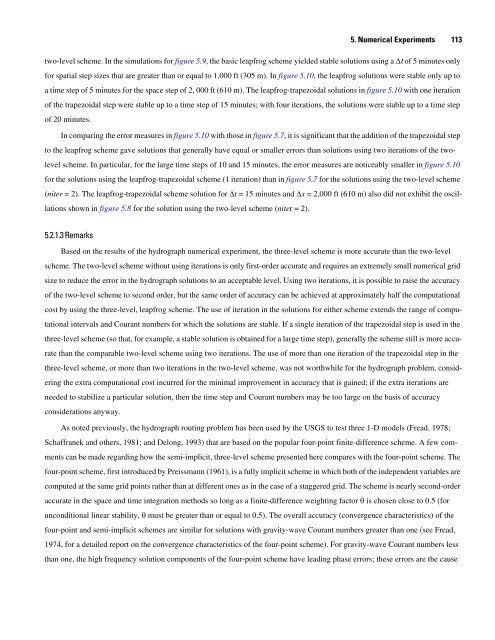A Semi-Implicit, Three-Dimensional Model for Estuarine ... - USGS
A Semi-Implicit, Three-Dimensional Model for Estuarine ... - USGS
A Semi-Implicit, Three-Dimensional Model for Estuarine ... - USGS
Create successful ePaper yourself
Turn your PDF publications into a flip-book with our unique Google optimized e-Paper software.
5. Numerical Experiments 113<br />
two-level scheme. In the simulations <strong>for</strong> figure 5.9, the basic leapfrog scheme yielded stable solutions using a Δt of 5 minutes only<br />
<strong>for</strong> spatial step sizes that are greater than or equal to 1,000 ft (305 m). In figure 5.10, the leapfrog solutions were stable only up to<br />
a time step of 5 minutes <strong>for</strong> the space step of 2, 000 ft (610 m). The leapfrog-trapezoidal solutions in figure 5.10 with one iteration<br />
of the trapezoidal step were stable up to a time step of 15 minutes; with four iterations, the solutions were stable up to a time step<br />
of 20 minutes.<br />
In comparing the error measures in figure 5.10 with those in figure 5.7, it is significant that the addition of the trapezoidal step<br />
to the leapfrog scheme gave solutions that generally have equal or smaller errors than solutions using two iterations of the two-<br />
level scheme. In particular, <strong>for</strong> the large time steps of 10 and 15 minutes, the error measures are noticeably smaller in figure 5.10<br />
<strong>for</strong> the solutions using the leapfrog-trapezoidal scheme (1 iteration) than in figure 5.7 <strong>for</strong> the solutions using the two-level scheme<br />
(niter = 2). The leapfrog-trapezoidal scheme solution <strong>for</strong> Δt = 15 minutes and Δx = 2,000 ft (610 m) also did not exhibit the oscil-<br />
lations shown in figure 5.8 <strong>for</strong> the solution using the two-level scheme (niter = 2).<br />
5.2.1.3 Remarks<br />
Based on the results of the hydrograph numerical experiment, the three-level scheme is more accurate than the two-level<br />
scheme. The two-level scheme without using iterations is only first-order accurate and requires an extremely small numerical grid<br />
size to reduce the error in the hydrograph solutions to an acceptable level. Using two iterations, it is possible to raise the accuracy<br />
of the two-level scheme to second order, but the same order of accuracy can be achieved at approximately half the computational<br />
cost by using the three-level, leapfrog scheme. The use of iteration in the solutions <strong>for</strong> either scheme extends the range of compu-<br />
tational intervals and Courant numbers <strong>for</strong> which the solutions are stable. If a single iteration of the trapezoidal step is used in the<br />
three-level scheme (so that, <strong>for</strong> example, a stable solution is obtained <strong>for</strong> a large time step), generally the scheme still is more accu-<br />
rate than the comparable two-level scheme using two iterations. The use of more than one iteration of the trapezoidal step in the<br />
three-level scheme, or more than two iterations in the two-level scheme, was not worthwhile <strong>for</strong> the hydrograph problem, consid-<br />
ering the extra computational cost incurred <strong>for</strong> the minimal improvement in accuracy that is gained; if the extra iterations are<br />
needed to stabilize a particular solution, then the time step and Courant numbers may be too large on the basis of accuracy<br />
considerations anyway.<br />
As noted previously, the hydrograph routing problem has been used by the <strong>USGS</strong> to test three 1-D models (Fread, 1978;<br />
Schaffranek and others, 1981; and Delong, 1993) that are based on the popular four-point finite-difference scheme. A few com-<br />
ments can be made regarding how the semi-implicit, three-level scheme presented here compares with the four-point scheme. The<br />
four-point scheme, first introduced by Preissmann (1961), is a fully implicit scheme in which both of the independent variables are<br />
computed at the same grid points rather than at different ones as in the case of a staggered grid. The scheme is nearly second-order<br />
accurate in the space and time integration methods so long as a finite-difference weighting factor θ is chosen close to 0.5 (<strong>for</strong><br />
unconditional linear stability, θ must be greater than or equal to 0.5). The overall accuracy (convergence characteristics) of the<br />
four-point and semi-implicit schemes are similar <strong>for</strong> solutions with gravity-wave Courant numbers greater than one (see Fread,<br />
1974, <strong>for</strong> a detailed report on the convergence characteristics of the four-point scheme). For gravity-wave Courant numbers less<br />
than one, the high frequency solution components of the four-point scheme have leading phase errors; these errors are the cause

















